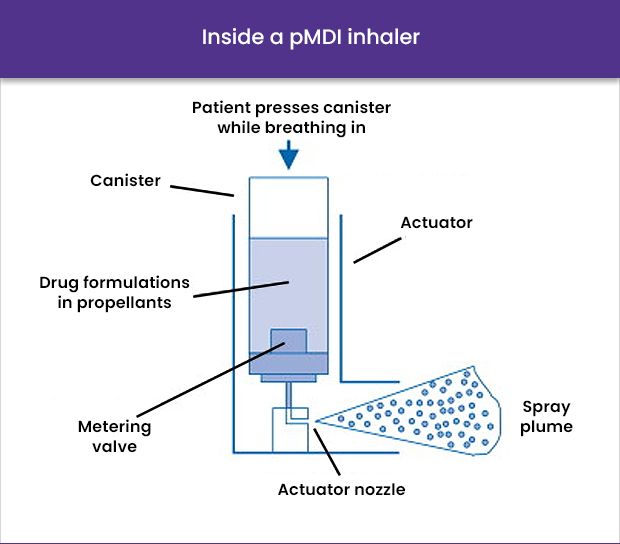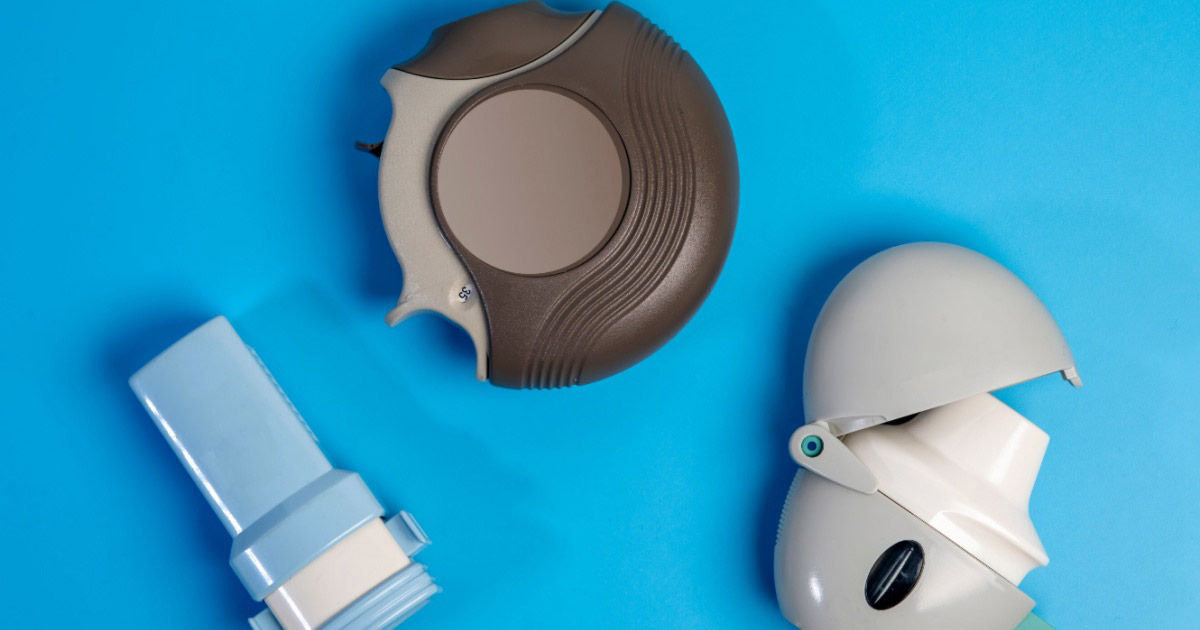- Private & confidential service
- Genuine medication
- All-inclusive service - No hidden fees
- Next day delivery
- Asthma
- Inhalers and the planet: how to lower your carbon footprint
Inhalers and the planet: how to lower your carbon footprint
Inhalers are essential treatments for lung conditions such as asthma and COPD.
However, some inhalers can be highly damaging to the planet. Some inhaler devices release greenhouse gases thousands of times more powerful than CO2.
Luckily, equally effective inhalers exist that do not harm the planet. Learn more about how inhalers impact the planet and what you can do.
How do inhalers affect the environment?
Inhalers work by delivering a measured amount of medication directly into your lungs to relieve symptoms and control your lung condition.
The most common type of inhalers are known as pressurised metered dose inhalers (pMDIs). It contains a pressurised propellant (a gas) in an aerosol chamber.

This chemical propellant is what produces the spray, or a puff, that helps deliver the medicine. However, the propellant used in these inhalers contains man-made greenhouse gases that are harmful to the environment.
Greenhouse gases, such as carbon dioxide (CO2), water vapour and methane are harmful because they trap heat in the earth’s atmosphere. Gradually, this has resulted in global warming and climate change.
The carbon footprint of inhalers
A carbon footprint is the total amount of greenhouse gases generated by our actions and a measure of our impact on the environment.
This is often measured in carbon dioxide equivalents (CO2e). It means the number of greenhouse gases emitted in terms of the equivalent measurement of carbon dioxide. Basically, the higher the CO2e, the more damaging it is to the climate.
Carbon footprint of inhalers
The greenhouse gases used in inhalers are around 1300 times more powerful than carbon dioxide (CO2). They contribute to around 3% of the NHS's CO2 emissions.
Above is a chart of the carbon footprint of commonly prescribed inhalers. Shockingly, one puff of a Symbicort inhaler can emit as much CO2e as a 115-mile (185km) car journey.
Which inhalers are bad for the environment?
Inhalers known as pressurised metered dose inhalers (pMDIs) are the most damaging to the planet. They are often known as “puffers”.
They are the most common type of inhaler. In fact, 97% of inhalers prescribed globally are pMDIs. However, they contain a propellant gas which helps deliver the medicine to your airways.

You press down on the canister as you breathe in and the medicine is released along with the propellant.
Common pMDIs include:
Breath-actuated inhalers (BAIs)
BAIs also contain a propellant gas, similar to pMDIs. However, they are simpler to use as the medicine is released automatically as you breathe in.
Common BAIs include:
- Salamol Easi-breathe
- Qvar Autohaler
- Qvar Easi-breathe
CFC-free inhalers
Some inhalers are labelled and advertised as being CFC-free.
This is because the earliest inhalers contained gases called CFCs, which acted as the propellant. However, as inhalers were modernised, they were made with HFAs which do less damage to the ozone layer than CFCs.
Most modern inhalers now contain HFAs. However, they are still greenhouse gases and still damage the planet.
Which inhalers are best for the environment?
There are two types of inhalers that do not contain propellants and are therefore better for the environment. These are called dry powder inhalers (DPIs) and soft mist inhalers (SMIs).
Dry powder inhalers (DPIs)
DPIs are small devices that deliver medicine to your lungs in the form of a dry powder.
Unlike pMDIs, you need to load the dose yourself. You either press a button or lever, load a capsule or twist a dial. The medicine is released automatically when you breathe in.

Some of the most common DPIs include:
- Bricanyl Turbohaler
- Flixotide Accuhaler
- Fostair NEXThaler
- Pulmicort Turbohaler
- Salbutamol Easyhaler
- Symbicort Turbohaler
There are several types of DPIs, that all work slightly differently. Make sure you follow your doctor’s instructions when using one.
Soft mist inhalers (SMIs)
SMIs deliver the medicine through a fine mist. They do not contain a propellant. The medicine is released mechanically.
You press a button on the device. It releases the medicine more slowly and for a longer duration than pMDIs.

The most common type of SMI is Spiriva Respimat. It is only available at the moment for severe asthma.
Can I change inhalers?
You should be able to convert to a low-carbon inhaler depending on your condition.
You should discuss it with your doctor. If they think it is safe and suitable for you to switch inhalers, they can prescribe you a DPI or SMI.
You should continue taking your inhaler as normal. Do not stop taking it or change your treatment without asking your doctor.
What if I can’t change inhalers?
If your doctor does not think it is right for you, there are still things you can do to lower your carbon footprint.
Keep your asthma under control. This will mean you will need to take your reliever inhaler less, which means fewer gases are emitted. You can check whether your asthma is well controlled using our tool below.
Make sure you are using your inhalers correctly. This will prevent excess greenhouse gases in the atmosphere as well as control your asthma better.
Mild to severe asthma exacerbations resulted in 724,201 tonnes of greenhouse gas emissions a year. This is equivalent to the emissions of 157,000 passenger vehicles driven in a year.
Talk to your doctor about changing your inhaler dose. You may be able to use less puffs with the same inhaler.
Do not change your dosage or inhaler without your doctor’s advice.
Talk to your doctor about choosing a more environmentally friendly pMDI. Certain brands contain less propellants in each puff (e.g. Ventolin).
Do not stockpile inhalers. If you have more than you need, they may expire and be wasted.
Can I recycle inhalers?
Yes, some inhalers can be recycled.
However, they cannot be recycled with your household waste as the propellant gas could leak out over time.
If you have an empty or old inhaler, take it to your local pharmacy to be disposed of. It will be either recycled or incinerated.
Final thoughts
MDI and BAI inhalers contribute to global warming, as they release harmful greenhouse gases into the atmosphere.
If it is suitable for your condition, you may be able to switch to a low-carbon alternative such as a DPI or SMI. Or, you might be able to change your current dosage.
If you can’t switch, using your inhaler correctly and managing your condition will help reduce excess emissions.
Consult your doctor if you want to change inhalers.
See our inhaler options online
View treatmentsmedical form
medication
prescription
from pharmacy


